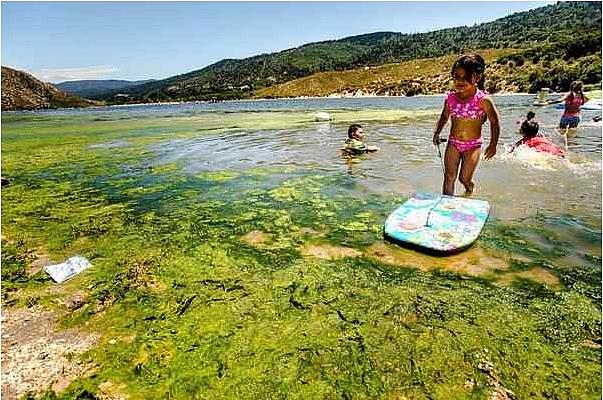What’s being done to assess blue-green algae’s risk to humans
This article was produced as a project for the 2015 California Data Fellowship, a program of the Center for Health Journalism at the USC Annenberg School for Communication and Journalism.
Other stories in the series include:
Wading into danger: Growth of toxic algae could make California's lakes unsafe?
Toxic algae is blooming more often in our lakes, reservoirs. Does that threaten our drinking water?
Don’t go swimming at Pyramid Lake due to toxic algae bloom, water officials say

Children play in water infested with blue-green algae at Silverwood Lake in San Bernardino County on Sunday, June 19, 2016. The algae is known to produce toxins that can kill dogs and make people sick. (Photo by Watchara Phomicinda/ Southern California News Group)
When her dog suddenly died after being exposed to toxic blue-green algae at Lake Chabot in the Bay Area, Marcella Schantz wondered whether humans, too, were at risk.
“I see kids going down to the shore there. Little kids,” said Schantz, 59, of Castro Valley, whose dog Ginger fell ill and later died after a hike near the lake in late 2014. “Kids are just going there to have a good time.”
There are no confirmed human deaths linked to toxins produced by cyanobacteria, commonly known as blue-green algae, in the U.S., but in the wake of reports of dogs dying from ingesting these toxins, people are worried about the potential harm to humans.
Dogs are more likely to be sickened by cyanotoxins because they ingest more water while swimming and lick algae off their fur. However, the toxins are still dangerous for humans, experts say, and with the numbers of toxin-producing bacteria rising amid California’s drought, the risk of human illness is as high as ever.
“As you have more blooms, you’re obviously going to have more poisoning,” said Wayne Carmichael, a professor emeritus at Ohio’s Wright State University who has studied cyanotoxins for more than 40 years.
Few Cases of Human Illness
Cyanotoxins cause a range of adverse health effects, including skin rashes, diarrhea, vomiting, confusion, liver damage and even cancer. But experts don’t have a good idea of how many humans are actually being exposed to the toxins nor do they understand the extent of health impacts from short-term exposure associated with recreational activities or chronic exposure associated with drinking water.
“We know it causes problems, so it’s a pretty good guess that chronic exposure is bad in humans also,” said UC Santa Cruz professor Raphael Kudela, who studies cyanotoxins.
Kudela said people have reported getting “very severe rashes” from swimming in toxin-infested lakes, adding that they often ignore signs advising against contact with the water.
“It’s not illegal to get in the water, so they don’t stop people,” he said.
A 2014 study by the Centers for Disease Control and Prevention found that of the 14 cyanotoxin-related outbreaks that have been reported to the health agency since 1978, 79 percent, or 11 outbreaks, affecting 61 people in three states were reported between 2009 and 2010.
The study noted that due to the “nonspecific nature” of the health effects reported by the people who fell ill, including diarrhea, fever and joint pain, it might be difficult for medical professionals to identify an illness as being related to a harmful algae bloom.
The Need For More Education
One thing experts say could improve their understanding of the health impacts to people is increasing the amount of public outreach about the issue. While other states have monitored cyanotoxins in recreational water for years and have established illness reporting systems, there are a lot of people who have never heard of blue-green algae in California.
“People go to the emergency room and sometimes they have a rash or respiratory issue and sometimes they make the connection that they were swimming,” said Karen Taberski, a senior environmental scientist for the State Water Resources Control Board. “A lot of times the medical personnel aren’t aware.”
As part of a plan to better assess and manage cyanotoxins across the state, the water board and a group of other state agencies, water managers and tribes, collectively known as the California Cyanobacteria Harmful Algal Bloom Network, want to educate local authorities about the issue and teach them how to address it.
Nationwide, the CDC recently launched a new surveillance system where states can report cases of cyanotoxin-related illnesses.
“We do have some information, but there’s still a lot of unknowns,” said Virginia Roberts, an epidemiologist for the Centers for Disease Control and Prevention. “This will help us understand the epidemiology, who becomes ill and when they become ill, and support our efforts to prevent those illnesses in the future.”
[This story was originally published by SGVT.]

